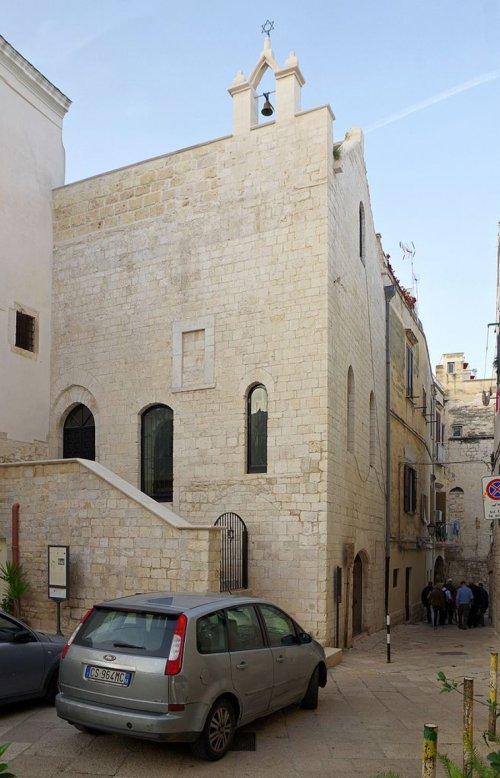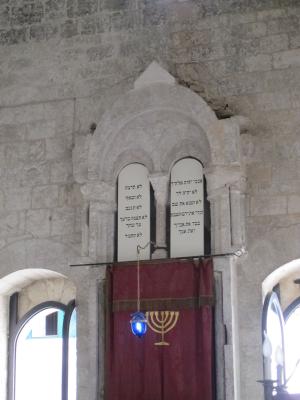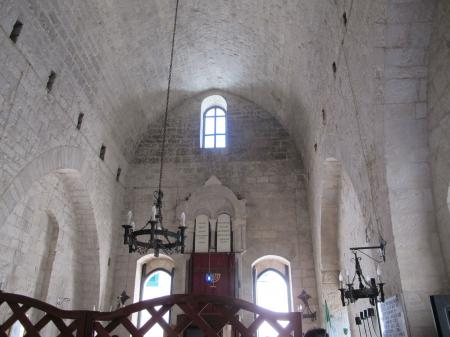Obj. ID: 30576
Jewish Architecture Medieval Scolanuova Synagogue in Trani, Italy

Summary and Remarks
Remarks
sub-set tree:
Name/Title
Medieval Scolanuova Synagogue in Trani | Unknown
Object
Object Detail
Monument Setting
Unknown
Date
1240
Synagogue active dates
until 1510, from 2004
Reconstruction dates
2006
Artist/ Maker
Unknown
Historical Origin
Unknown
Community type
Congregation
Site
Unknown
School/Style
Unknown|
Period
Unknown
Period Detail
Collection
Unknown |
Documentation / Research project
Unknown
Iconographical Subject
Unknown |
Textual Content
Unknown |
Languages of inscription
Unknown
Shape / Form
Unknown
Material / Technique
Material Stucture
Material Decoration
Material Bonding
Material Inscription
Material Additions
Material Cloth
Material Lining
Tesserae Arrangement
Density
Colors
Construction material
Stone
Measurements
Height
Length
Width
Depth
Circumference
Thickness
Diameter
Weight
Axis
Panel Measurements
Condition
Extant
Documented by CJA
Surveyed by CJA
Present Usage
Synagogue
Present Usage Details
Condition of Building Fabric
B (Fair)
Architectural Significance type
Historical significance: Event/Period
Trani was home to a large Jewish community from the first part of the 11th century, but the community largely disappeared with forced conversions at the end of the 13th/beginning of the 14th century. Benjamin of Tudela visited in the 12th century, describing: “Trani on the sea, where all the pilgrims gather to go to Jerusalem; for the port is a convenient one. A community of about 200 Israelites is there, at their head being R. Elijah, R. Nathan, the expounder, and R. Jacob. It is a great and beautiful city.” Final expulsion of Jews came in 1510.
There is an old Jewish quarter, or Giudecca. Central to the Guidecca were four medieval synagogues, which served the community (or distinct parts of it) up until ca. 1300, when all four were converted into churches, renamed and rebuilt:
1) Santa Maria in Scolanova (Scolanova ia Judeo-Italian for “New Synagogue”)
2) San Leonardo Abate (little of the original building remains)
3) San Pietro Martire (later demolished)
4) Santi Quirico e Gioveta (Since renamed Sant’ Anni in Trani). This was once the Scolagrande Synagoge. Today it holds the local Jewish Museum, part of the Diocese Museum
There is an old Jewish quarter, or Giudecca. Central to the Guidecca were four medieval synagogues, which served the community (or distinct parts of it) up until ca. 1300, when all four were converted into churches, renamed and rebuilt:
1) Santa Maria in Scolanova (Scolanova ia Judeo-Italian for “New Synagogue”)
2) San Leonardo Abate (little of the original building remains)
3) San Pietro Martire (later demolished)
4) Santi Quirico e Gioveta (Since renamed Sant’ Anni in Trani). This was once the Scolagrande Synagoge. Today it holds the local Jewish Museum, part of the Diocese Museum
Historical significance: Collective Memory/Folklore
Historical significance: Person
Architectural Significance: Style
Architectural Significance: Artistic Decoration
Urban significance
Part of Jewish quarter
Significance Rating
3 (National)
0
Ornamentation
Custom
Contents
Codicology
Scribes
Script
Number of Lines
Ruling
Pricking
Quires
Catchwords
Hebrew Numeration
Blank Leaves
Direction/Location
Façade (main)
Endivances
Location of Torah Ark
Location of Apse
Location of Niche
Location of Reader's Desk
Location of Platform
Temp: Architecture Axis
Arrangement of Seats
Location of Women's Section
Direction Prayer
Direction Toward Jerusalem
Coin
Coin Series
Coin Ruler
Coin Year
Denomination
Signature
Colophon
Scribal Notes
Watermark
Hallmark
Group
Group
Group
Group
Group
Trade Mark
Binding
Decoration Program
Suggested Reconsdivuction
History/Provenance
The building was re-converted to its function as a Synagogue in 2005,
The building has retained its original structure over the centuries: a rectangular hall raised above ground level entered via an external staircase built against the south wall. Inside, on the east wall, is the stone aedicule that housed the Torah ark. Here, the floor is raised by three steps, and this is where the Christian altar was placed after the synagogue was turned into a church. A large hole was found in the floor of the basement, possibly a remnant of a ritual bath.
Today, the synagogue is managed by the Jewish Community of Naples, of which Trani is a branch. It generally opens on various Jewish religious holidays, when the local Jewish community gathers here.
Main Surveys & Excavations
Sources
Type
Documenter
|
Author of description
|
Architectural Drawings
|
Computer Reconstruction
|
Section Head
|
Language Editor
|
Donor
|
Object Copyright
Negative/Photo. No.
The following information on this monument will be completed:
Unknown |










